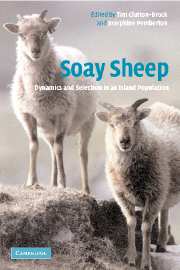Book contents
- Frontmatter
- Contents
- List of contributors
- Editors' and Authors' Acknowledgements
- 1 Individuals and populations
- 2 The sheep of St Kilda
- 3 Population dynamics in Soay sheep
- 4 Vegetation and sheep population dynamics
- 5 Parasites and their impact
- 6 Mating patterns and male breeding success
- 7 Selection on phenotype
- 8 Molecular genetic variation and selection on genotype
- 9 Adaptive reproductive strategies
- 10 The causes and consequences of instability
- Appendix 1 The flora of St Kilda
- Appendix 2 Inheritance of coat colour and horn type in Hirta Soay sheep
- Appendix 3 How average life tables can mislead
- References
- Index
- Plate section
10 - The causes and consequences of instability
Published online by Cambridge University Press: 07 December 2009
- Frontmatter
- Contents
- List of contributors
- Editors' and Authors' Acknowledgements
- 1 Individuals and populations
- 2 The sheep of St Kilda
- 3 Population dynamics in Soay sheep
- 4 Vegetation and sheep population dynamics
- 5 Parasites and their impact
- 6 Mating patterns and male breeding success
- 7 Selection on phenotype
- 8 Molecular genetic variation and selection on genotype
- 9 Adaptive reproductive strategies
- 10 The causes and consequences of instability
- Appendix 1 The flora of St Kilda
- Appendix 2 Inheritance of coat colour and horn type in Hirta Soay sheep
- Appendix 3 How average life tables can mislead
- References
- Index
- Plate section
Summary
Introduction
This final chapter reviews our understanding of the causes and consequences of fluctuations in sheep numbers on St Kilda and sets our results in the context of other studies. It is structured around the three main questions that we have tried to answer (see section 1.1): how are sheep numbers regulated and what physical and biological processes are responsible for changes in population size? How do changes in population density affect selection? And how do they affect the optimal reproductive strategies of individuals? The first section (10.2), examines the causes of death and the reasons why, unlike many other ungulate populations, the population of Soay sheep on Hirta shows such large fluctuations in size. In addition, it reviews the demographic consequences of changes in population size, including the effects of variation in density on development. Section 10.3 examines the impact of fluctuations in sheep numbers on the opportunity for selection and the intensity of selection on particular traits and speculates on the role these changes may play in maintaining genetic and phenotypic diversity. Fluctuations in sheep numbers also affect the costs and benefits of reproduction: section 10.4 reviews evidence of these changes and examines their consequences for the optimal breeding strategies of the sheep. Finally, section 10.5 examines the relevance of work on St Kilda to understanding the dynamics of other resource-limited populations of mammals, arguing that the demographic processes operating in the sheep are probably found in many other resource-limited populations.
- Type
- Chapter
- Information
- Soay SheepDynamics and Selection in an Island Population, pp. 276 - 310Publisher: Cambridge University PressPrint publication year: 2003
- 1
- Cited by

